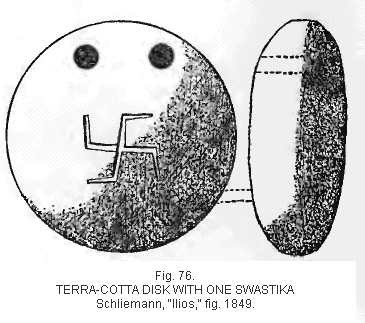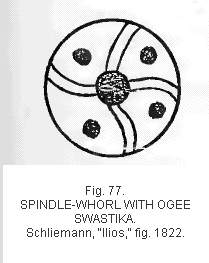

The Swastika
Dispersion of the Swastika
The specimen represented in fig. 76
 is
not a spindle-whorl, as shown by the number and location of the holes.
It bears a good representation of a Swastika the form of which has been
noticed several times. The two main arms cross each other at nearly right
angles. The ends of the arms all bend to the right at a slightly obtuse
angle and turn outward with a flourish somewhat after the style of the
Jain Swastika (fig. 34c).
Fig. 77 represents a spindle-whorl with a Swastika of the ogee style curved
to the right. The center hole of the whorl forms the center of the sign.
The figure of double lines, and in the interspaces are four dots, similar
to those in figs. 96, 97
and 98, the others which Dr.
Schliemann reports as common, and to which he attributes some special
but unknown meaning. Swastikas and crosses of irregular shope and style
are shown in the field of fig. 78.
Two fairly well formed Swastikas appear,
is
not a spindle-whorl, as shown by the number and location of the holes.
It bears a good representation of a Swastika the form of which has been
noticed several times. The two main arms cross each other at nearly right
angles. The ends of the arms all bend to the right at a slightly obtuse
angle and turn outward with a flourish somewhat after the style of the
Jain Swastika (fig. 34c).
Fig. 77 represents a spindle-whorl with a Swastika of the ogee style curved
to the right. The center hole of the whorl forms the center of the sign.
The figure of double lines, and in the interspaces are four dots, similar
to those in figs. 96, 97
and 98, the others which Dr.
Schliemann reports as common, and to which he attributes some special
but unknown meaning. Swastikas and crosses of irregular shope and style
are shown in the field of fig. 78.
Two fairly well formed Swastikas appear, both of the ogee style, with the ends curved to the right. One is of the
style resembling the figure 8 (see figs.
60 and 64). Two others are
crudely and irregularly formed, and would scarcely be recognized as Swastikas
except for their association. Fig.
79 represents uncertain and malformed Swastikas. The arms are bent
in different directions in the same line. Two of the main arms are not
bent. The inexplicable dots are present, and the field is more or less
covered with unmeaning or, at least, unexplained marks. Figs.
80 also illustrates the indefinite and inchoate style of decoration.
One unfinished Swastika appears which, unlike anything we have yet seen,
has a circle with a dot in the center for the body of the Swastika at
the crossing of the main arms. Fig.
81 shows two Swastikas, both crossing their main arms at right angles
and the ends bending also at right angles–one to the right, the other
to the left. This specimen is inserted here because of the numerous decorations
of apparently unmeaning, or, at least, unexplained, lines. Fig.
82 shows four segmented circles with an indefinite Swastika in one
of the spaces. The ends are not well turned, only one being well attached
to the main arms. One of the ends is not joined, one overruns and forms
a sort of cross; the other has no bend. Fig.
83 contains an unmistakable Swastika, the main arms of which cross
at right angles, turning to the left with an ogee curve. The peculiarity
of this specimen is that the center of the sign is inclosed in a circle,
thus showing the indifference
both of the ogee style, with the ends curved to the right. One is of the
style resembling the figure 8 (see figs.
60 and 64). Two others are
crudely and irregularly formed, and would scarcely be recognized as Swastikas
except for their association. Fig.
79 represents uncertain and malformed Swastikas. The arms are bent
in different directions in the same line. Two of the main arms are not
bent. The inexplicable dots are present, and the field is more or less
covered with unmeaning or, at least, unexplained marks. Figs.
80 also illustrates the indefinite and inchoate style of decoration.
One unfinished Swastika appears which, unlike anything we have yet seen,
has a circle with a dot in the center for the body of the Swastika at
the crossing of the main arms. Fig.
81 shows two Swastikas, both crossing their main arms at right angles
and the ends bending also at right angles–one to the right, the other
to the left. This specimen is inserted here because of the numerous decorations
of apparently unmeaning, or, at least, unexplained, lines. Fig.
82 shows four segmented circles with an indefinite Swastika in one
of the spaces. The ends are not well turned, only one being well attached
to the main arms. One of the ends is not joined, one overruns and forms
a sort of cross; the other has no bend. Fig.
83 contains an unmistakable Swastika, the main arms of which cross
at right angles, turning to the left with an ogee curve. The peculiarity
of this specimen is that the center of the sign is inclosed in a circle,
thus showing the indifference << Previous Page Next Page >>
© 2004-2007 Northvegr.
Most of the material on this site is in the public domain. However, many people have worked very hard to bring these texts to you so if you do use the work, we would appreciate it if you could give credit to both the Northvegr site and to the individuals who worked to bring you these texts. A small number of texts are copyrighted and cannot be used without the author's permission. Any text that is copyrighted will have a clear notation of such on the main index page for that text. Inquiries can be sent to info@northvegr.org. Northvegr™ and the Northvegr symbol are trademarks and service marks of the Northvegr Foundation.

|